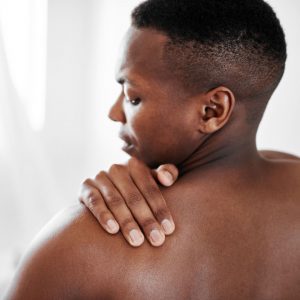Shoulder Sprain vs. Shoulder Strain
 Shoulder sprains and shoulder strains affect different parts of the shoulder, although both injuries can be painful and debilitating.
Shoulder sprains and shoulder strains affect different parts of the shoulder, although both injuries can be painful and debilitating.
What is the difference between shoulder sprain and shoulder strain?
Sprains are injuries that affect the broad bands of cartilage (ligaments) that connect bones to each other. A sprain develops when ligaments are stretched too far or torn. One typical way a sprain occurs is trauma (a blow to the area) that displaces the shoulder joint from its normal position.
Strains are injuries that affect muscles or the thick bands that attach bones to muscles (tendons). A sudden twist, tear, or pull of the shoulder muscle can cause a strain. Strains can happen from over contracting or overstretching the shoulder muscles or tendons.
How do you diagnose shoulder strain and shoulder sprain?
It's difficult to diagnose whether you have a shoulder sprain or strain on your own because the symptoms are similar. It's best to see your doctor.
Your doctor determines whether you have a shoulder sprain or strain by ruling out other causes. After a physical exam, your doctor may have an X-ray performed to make sure the symptoms are not from a bone break or fracture. An MRI may also be conducted for further information. If neither test shows any bone injuries, your doctor will likely diagnose the injury as a sprain or strain.
What are the symptoms of shoulder strain and shoulder sprain?
Shoulder strains can cause muscle spasms and sprains can cause bruising. They both can cause:
- shoulder joint pain
- swelling
- limited range of motion and flexibility
How long does it take to cure shoulder sprain and shoulder strain?
Following a shoulder injury, for the first 24 to 48 hours, the RICE METHOD (rest, ice, compression, and elevation) may alleviate symptoms. If you have a more severe injury, you may need surgery to repair damaged or torn tendons, muscles, or ligaments
How do you fix a shoulder strain?
If the RICE method does not relieve symptoms of a shoulder strain, then surgery may be needed to fix the problem. There are two types of shoulder surgery: arthroscopic surgery and open shoulder surgery.
- Arthroscopic surgery involves your surgeon making one or more keyhole type incisions. Your doctor then accesses the area to be repaired by inserting small surgical instruments through these incisions.
- Open shoulder surgery involves your surgeon making one large incision to view the full shoulder and make repairs.
How do you fix a shoulder sprain?
You can treat your shoulder sprain with the RICE method as well, but if it is a tear, surgery may be needed. Arthroscopic surgery and open shoulder surgery are the two surgical options available.
Can a shoulder sprain heal on its own?
It could take several weeks to several months for a shoulder sprain to heal on its own depending on its severity. For less severe sprains, the RICE method, anti-inflammatory medications, and keeping your arm in a sling can help the sprain heal on its own. Exercises to help restore your range of motion can help, but talk to your doctor first.
Can a shoulder strain heal on its own?
If your shoulder strain has no serious tears, the RICE method, anti-inflammatory medications, and keeping your arm in a sling can help the strain heal on its own. Exercises to help restore your range of motion can help, but talk to your doctor first.
What happens if shoulder strain and shoulder sprain are left untreated?
What you believe to be a strain or a sprain can really be a fracture or some other injury. If you leave a shoulder injury untreated, you’re taking unnecessary risks that can lead to further complications.
When should you see a doctor for shoulder strain and shoulder sprain?
If you suffer a shoulder injury, visit your doctor, especially if you:
- have significant swelling and/or bruising
- experience serious pain
- can't move your shoulder, or you can move it very little
- still have symptoms after resting your shoulder for a few days
If you are experiencing symptoms of shoulder strain or sprain, a consultation with an orthopedic specialist may be the first step towards diagnosis, treatment, and recovery. Dr. Burrus is an experienced fellowship-trained orthopedic surgeon who is dedicated to providing high-quality, specialized holistic care. Call 512.477.6341 or fill out the form on this page to schedule an appointment.